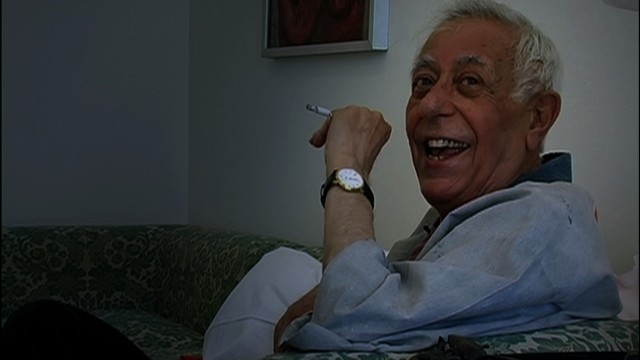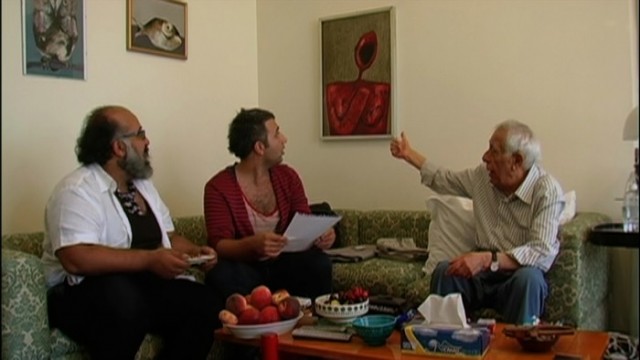
Iconoclastic and opinionated artist Bahman Mohassess opens up about his life and career in FIFI HOWLS FROM HAPPINESS
FIFI HOWLS FROM HAPPINESS (Mitra Farahani, 2013)
Lincoln Plaza Cinema
1886 Broadway at 63rd St.
Opens Friday, August 8
212-757-2280
www.lincolnplazacinema.com
www.musicboxfilms.com
 “I really don’t understand what this film you are making about me is all about. If it’s a film about a subject, I must know what role it is I am to play,” Iranian-born, Rome-based artist Bahman Mohassess tells director Mitra Farahani in the captivating, bittersweet documentary Fifi Howls from Happiness. “I don’t know the structure of your work. How does it start? What does it want to say? And where does it end?” he continues. A successful artist in his home country, Mohassess ultimately left Iran for Italy because of regime change and political unrest, which eventually involved government destruction of his work. He was so outraged that he destroyed even more of his own creations and eventually stopped showing his paintings, sculptures, and collages. Iranian artist and documentarian Farahani (Just a Woman, Zohre and Manouchehr) went in search of Mohassess, finding him living as a near-recluse in a hotel in Rome. The iconoclastic artist opens up to Farahani, talking about his parents and the end of his era while expressing his doubt about future generations. He also shares his views on the censorship and destruction of his art, political and social mores, inheritance, legacy, the general devastation going on around the world, and death. “I am only one John the Baptist, preaching alone in the desert,” he says. “It will make no difference. It never will.” In addition, he regularly tells Farahani what she should be doing with her film, directing the director, even though he points out, “I am not directing. I am only giving you my opinion.”
“I really don’t understand what this film you are making about me is all about. If it’s a film about a subject, I must know what role it is I am to play,” Iranian-born, Rome-based artist Bahman Mohassess tells director Mitra Farahani in the captivating, bittersweet documentary Fifi Howls from Happiness. “I don’t know the structure of your work. How does it start? What does it want to say? And where does it end?” he continues. A successful artist in his home country, Mohassess ultimately left Iran for Italy because of regime change and political unrest, which eventually involved government destruction of his work. He was so outraged that he destroyed even more of his own creations and eventually stopped showing his paintings, sculptures, and collages. Iranian artist and documentarian Farahani (Just a Woman, Zohre and Manouchehr) went in search of Mohassess, finding him living as a near-recluse in a hotel in Rome. The iconoclastic artist opens up to Farahani, talking about his parents and the end of his era while expressing his doubt about future generations. He also shares his views on the censorship and destruction of his art, political and social mores, inheritance, legacy, the general devastation going on around the world, and death. “I am only one John the Baptist, preaching alone in the desert,” he says. “It will make no difference. It never will.” In addition, he regularly tells Farahani what she should be doing with her film, directing the director, even though he points out, “I am not directing. I am only giving you my opinion.”

Bahman Mohassess becomes reinvigorated when a pair of collectors want to commission a large-scale painting from him
The narrative takes a delightful turn when Farahani arranges for a pair of Dubai-based brothers and collectors, Rokni and Ramin Haerizadeh, to meet Mohassess and commission a large-scale work from him. Mohassess suddenly has renewed vigor, spouting poetry and showing them Luchino Visconti’s The Leopard. Farahani compares the events to the plot of Honoré de Balzac’s The Unknown Masterpiece, the two tales having remarkable similarities. Farahani also includes archival footage of Ahmad Faroughi’s 1967 documentary on Mohassess, The Eye That Hears, in which the artist, much younger then, states, “My work deals with one thing only, the condemnation of existence. . . . But at the same time I have compassion.” That just about sums up Mohassess, a beguiling mix of condemnation and compassion, a hugely talented artist who is seemingly devoid of any sentimentality, with a deep-throated, cackling laugh that is unlike any you’ve ever heard.